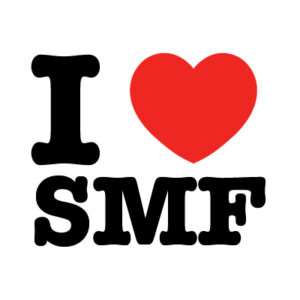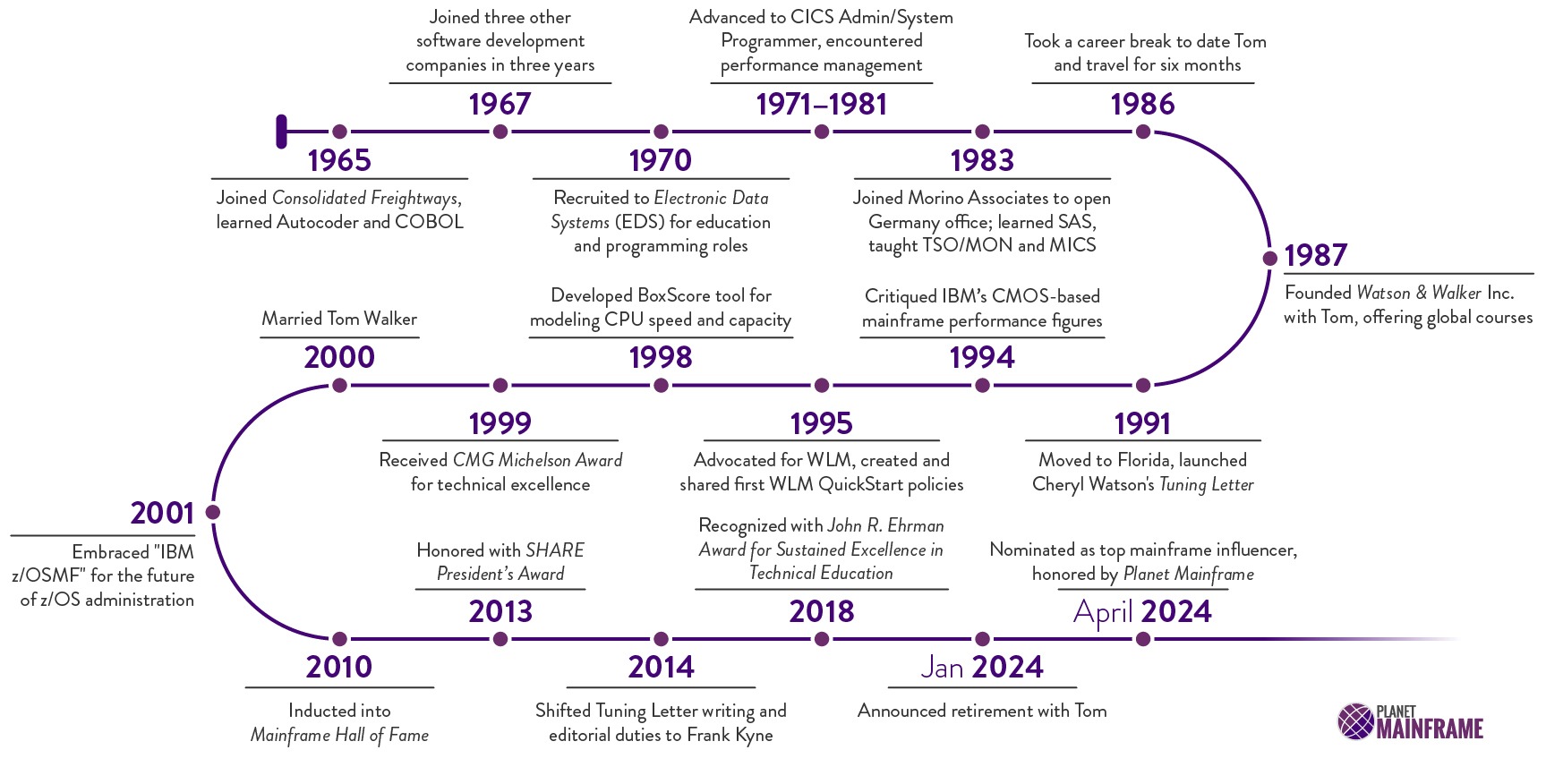Cheryl Watson’s career success, which spans more than 60 years, can be attributed to her relentless pursuit of knowledge, inquisitiveness, and her steadfast belief that the customer always comes first.
Fondly known as “the Mick Jagger of the mainframe” and “the shortest giant in the room,” Cheryl Watson’s intelligence and wit shine. She carries herself with confidence and a palpable joie de vivre.
Penney Berryman of Planet Mainframe caught up with her to discuss her recent retirement announcement, to reflect on her illustrious mainframe career, and to find out what’s next for this always-on woman.

Early Days
Cheryl’s foray into technology was not sparked by passion but by necessity. In 1965, armed with a math degree and the need to support her family, she faced a stark economic choice. “I wanted to teach. At the time, teachers made $325 per month. A trainee programmer made $500 per month. It was no contest!” she says victoriously.
Working for Consolidated Freightways, Cheryl was quickly hooked on mainframes, charmed by the hands-on nature of programming she did with the 605’s wire board. By the time the 360 came in, she was hooked. A lifelong passion had begun.
Cheryl is an admitted workaholic. “I loved IT so much, I’m afraid it’s the reason for a couple of my divorces,” she jokes.
“Work always came first. I usually worked 60-hour weeks. There would be 80 hours at times. But,” she says with a pause, “I have this…well, I’m a type A personality, so I’m always on the go. When I slow down, I get bored.”
When I slow down, I get bored.
When Cheryl says she rarely sits still, it’s not hyperbole. She left home in high school and earned a college degree in four years while working full-time. Her zest for life extends beyond academia and work. She intentionally skied off a cliff in the French Alps to paraglide and has dabbled in woodworking and photography. She has earned her pilot’s license, built and raced cars, and ridden horses. She worked for 16 companies, moved at least 50 times, and traveled to more countries than there are pages for passport stamps.
Creating New Opportunities
Embracing new challenges has been Cheryl’s career mantra. “My philosophy has always been to say ‘yes,’” she notes. I like to learn new things—the newer, the better. Because my work was all-consuming, I’d always say ‘yes’ if an employer asked me if I’d like to try a new area. That led me around the country and the globe, providing me with many opportunities.”
My philosophy has always been to say yes.
One memorable moment occurred when Cheryl received a call about an IMS problem in Mexico City. She didn’t know how to spell the acronym or even what it meant at the time, but she was quickly on her way. “I found some really great resources and books, and on the flight down, I found out how to tune it. It worked!”
She got the IMS DB running, the client was thrilled, and she reveled in her newfound knowledge. “Taking risks is part of my DNA” she says simply.
As her experience grew, she became the enterprise mainframe customer’s best advocate, keeping IBM accountable to its performance promises and helping companies get the most out of their mainframes. She pressed IBM for functionality, not just new features. If there were an award for holding feet to the fire, it would be hers.
Dave Jeffries, former VP for z/OS Development at IBM, commented that when he saw Cheryl in the room, “I knew that I would get a grilling. I also knew that I would come away with invaluable insights and suggestions.”
The Biggest Energy in the Room
Cheryl thrives on continual learning, competitive games, puzzles, and mental challenges, but her relationship with Tom Walker truly amplified her success.
When asked for advice on maintaining her supercharged energy, Cheryl has none. “It’s built-in,” she says with a shrug. “I’m naturally this way, and I think you either have it or you don’t. Tom has it.”
“Tom” is none other than Tom Walker, Cheryl’s proclaimed soul mate, whom she credits with making her a professional success.
Cheryl met Tom at a mixer for the Washington Ethical Society in Washington, DC, and the relationship put many things in focus for Cheryl. Fully aware of her tendency to overwork, Cheryl audaciously quit her job to be able to date Tom. Soon, they decided to step back from globetrotting and settled in Florida after launching their own company. Watson & Walker, Inc. came to fruition in 1987.
What I learned is that the more you ask questions, the more you learn.
“I saw how frustrated she was with the way her bosses treated their customers, so it was natural for me to suggest we start our own company and do everything her way,” says Tom. Watson & Walker’s success is undeniable, and Cheryl is adamant that she could not have done it alone. “Tom has been my rock since 1986. He made me who I am in the mainframe world.”
All Advice, No Ads
Watson & Walker’s flagship publication, Cheryl Watson’s Tuning Letter, was born in 1991.
Tom recalls, “I had worked on mainframes since 1965, but not IBM’s, so I took on the roles of editor and a beginner reader—asking questions a brand new IBM mainframer might ask while reading the article.” This dynamic has created a publication with high practicality across the industry.
The Tuning Letter is no puff piece. Full of informed advice, the newsletter changed the mainframe industry and even the trajectory of IBM z/OS systems. When Cheryl complained about troublesome software or hardware in an edition, IBM heard about it. “It’s my position to speak truth to power and represent the voice of the customer,” she offers nonchalantly.
Tom agrees. “She has always fought for the customer—whether for better IBM documentation or restoring deleted IBM web pages that she knew were still useful.” A cautious relationship with the industry giant evolved into mutual respect.
“IBM executives sometimes called our home to check with her before a major announcement, asking her opinion and about its possible reception,” Tom notes.
Honesty and technical detail became the hallmark of the newsletter. Cheryl relentlessly researched, parsing through eight or nine different manuals to solve one item. “People gravitated toward the honesty in everything that Watson & Walker did. We’re honest to a fault.”
Mainframes in the Future
The technological changes since Cheryl worked on her first machine surprised even her. Chuckling, she shakes her head, “I could never have imagined what mainframes are today. I thought I was good at predicting trends, but it turns out I’m not!”
She’s optimistic about the future of mainframes and has expectations, including predictions about AI. “I have great expectations for the mainframe,” she says thoughtfully. “They’re going to get larger because of AI. To stay competitive, companies have to use AI. The more AI they use, the more competitive businesses will be. AI will consume as many MIPS as you can feed it… and more!”
And does she have reservations about AI overreach? Only about self-learning AI in other contexts. “AI use in mainframes will be entirely different from self-learning AI robotics,” she predicts. “It’ll be more about data use and manipulation. Humans will still program it, and anyone can make a mistake.”
Worth Doing Well

Cheryl could fill a Rolodex with her honors, awards, and accomplishments. She names three specific projects that provide satisfaction and resonate with her ethos.
Cheryl initially pushed IBM’s WLM (Workload Manager) into mainframe collective consciousness when she outspokenly supported specific performance targets. In doing so, she faced considerable pushback from the user community, which didn’t want to accept or switch to WLM. Ever responsive, Cheryl worked with IBM to extend the conversion time and then published a starter set of WLM policies known as QuickStart.
When IBM introduced z/OSMF, it was slow, clunky, and a pain to use, so nobody would use it. But Cheryl saw its potential for other applications, and the chance to provide a new interface for people just learning the mainframe. She became a z/OSMF champion. It’s one more instance where she worked closely with IBM to help the acceptance.
Of all her successes, however, Cheryl holds the brightest torch for The Tuning Letter. “Thirty-three years of my heart and soul went into it. And Tom’s too. That’s what I’m most proud of: people can learn how mainframes came about, how Workload Manager came about, and the background behind z/OS. I’m proud of every single edition we published.”
It’s not hubris. The newsletter boasts over 8,500 pages of practical and impartial z/OS plus MVS tuning and measurement advice shared with nearly 9,000 subscribers. Indeed, Cheryl Watson’s Tuning Letter is Cheryl and Tom’s offspring.
Now, adding “retiree” to her CV, Cheryl and Tom are off to new adventures. While they are parasailing in South America and thinking of more ways to give back to their community, 70% of mainframe users will use a WLM QuickStart policy, unaware of Cheryl Watson who made it possible.

Penney Berryman, MPH (she/her), is a digital marketing storyteller at the intersection of culture and technology. Owner of Copper Sage Consulting, Penney blends creativity and results-driven expertise to craft captivating narratives.
Connect with her on LinkedIn.


Congratulations on your retirement Cheryl. I started my career in 1961 in the Air Force and my learning started with the IBM 604 board wiring. I went from the board wiring to the IBM 1401 then to the 360 series. When we met at AMFAS in 1983, you inspired me with your knowledge, dedication and a personality that shined everywhere. You have been my muse for the past 40 years. I continue to work because of the mainframe and the challenges it presents. when my enjoyment in those, then I will formally retire.
John Hammonds
ps; when i saw the interviewer name, I immediately thought of Penny Pasquesy.
Great article on Cheryl! I’m new to the mainframe community so I was just recently introduced to Cheryl Watson’s Tuning Guide and its an impressive publication and a great resource for learners.